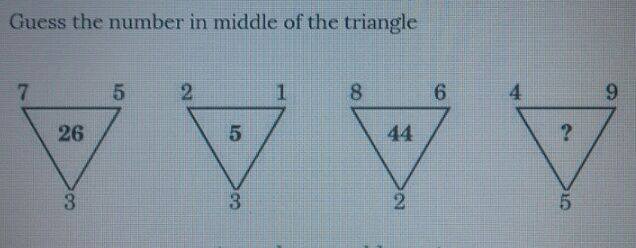Guess the Number Quiz 2

—————————————>>
A more thorough Explanation
Firstly, here’s a possible answer which follows this “pattern”:
There are ‘two patterns’ here, one for the “odd” positioned triangles (1 & 3 or a & c) and the other for “even” positioned triangles (2 & 4 or b & d) as shown below:
(a) (7 x 5) – 3^2 = 35 – 9 = 26
(b) (2 x 1) + 3 = 2 + 3 = 5
(c) (8 x 6) – 2^2 = 48 – 4 = 44
(d) (4 x 9) + 5 = 36 + 5 = 41
So, answer = 41.
The ‘problem’ with the solution above is that there are “two” patterns instead of one making even another solution like the next one below also ‘possible’:
(e) (7 x 5) – 3^2 = 35 – 9 = 26
(f) (3 x 2) – 1 = 6 – 1 = 5
(g) (8 x 6) – 2^2 = 48 – 4 = 44
(h) (5 x 4) – 9 = 20 – 9 = 11
Thus, the answer = 11 instead this time.
Hence we must look for a more conclusive way (if possible) so that “all” the given triangles follow “one-same” pattern.
Fortunately, there seems to be a way as described below:
Pattern:
(no. at top left corner) x (Difference of ‘other two’ numbers) + (Product of ‘other two’ numbers) + (- 1) x (No. at bottom of triangle – Triangle No. + 1)
For example, in the ‘first’ triangle (from the left) given in the picture, we have:
(no. at top left corner) = 7
(Difference of ‘other two’ numbers) = 5 – 3 = 2
(Product of ‘other two’ numbers) = 5 x 3 = 15
(No. at bottom of triangle) = 3
(Triangle No.) = 1
Yielding the Answers as follows:
(i) 7(5 – 3) + (5 x 3) + (- 1) x (3 – 1 + 1) = 26
(ii) 2(3 – 1) + (3 x 1) + (- 1) x (3 – 2 + 1) = 5
(iii) 8(6 – 2) + (6 x 2) + (- 1) x (2 – 3 + 1) = 44
(iv) 4(9 – 5) + (9 x 5) + (- 1) x (5 – 4 + 1) = 59
Hence, the more likely Answer = 59.

STAY CONNECTED